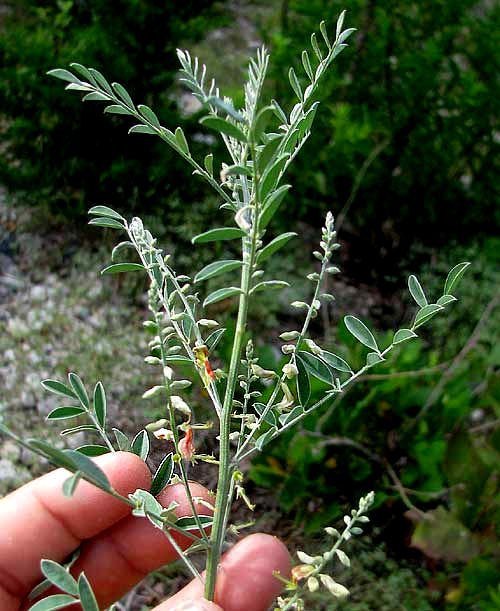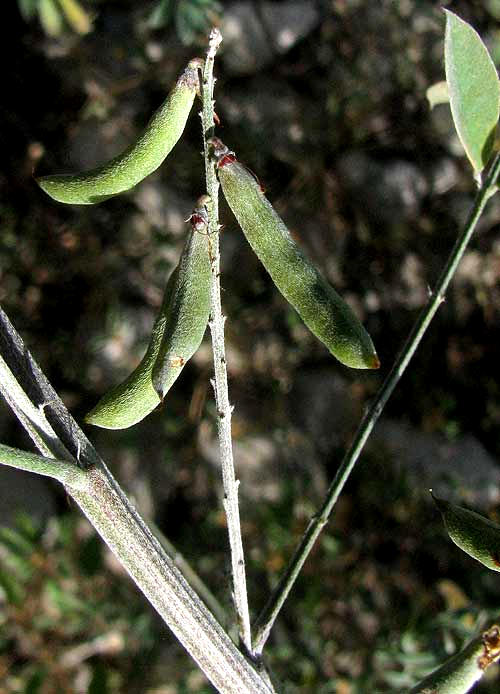Excerpts from Jim Conrad's
Naturalist Newsletter
from the August 11, 2013 Newsletter issued from the Frio Canyon Nature Education Center in the valley of the Dry Frio River in northern Uvalde County, southwestern Texas, on the southern border of the Edwards Plateau; elevation ~1750m (~5750 ft); N29.62°, W99.86°; USA
LINDHEIMER'S INDIGO
In much of North America these are the dog days of summer; here on most days the temperature hits 100 or above (38C). Sunlight burns and dazzles; in the afternoons you just want to sit in the shade where there's a good breeze. If during these mad-dog hours you wander the cobblestone floodplain beside the little Dry Frio River, you might come upon stands of waist-high bushes with such wispy branches and slight, pale leaves that the whole plants heave and sway. You squint through sweat trying to focus and hardly see what's before you. A picture of one of those chimerical presences is shown below:

Up close, details emerge: Alternate, pinnately compound leaves mantled with short, silvery hairiness; slender racemes of flowers arising on stiff peduncles where leaf petioles adjoin the stem... You can see this below:

In such heat and intense sunlight apparently the plant's flowers remain fresh only briefly, for in any given raceme only one or two blossoms among several can be found open at one time. In the raceme above the open blossoms there are flower buds not yet open, and below the open blossoms the corollas and stamens already have been cast off, leaving only pistils rapidly developing into fruits. A close-up showing two open flowers is shown below:

A large petal rising above (the banner) with two side petals (the wings) and two lower petals joined along their common margin to form a scoop-shaped structure (the keel)... Seeing this, instantly we know that we're dealing with the huge Bean Family. Such flowers are said to be "papilionaceous," and most Bean Family species produce flowers with such banners, wings and keels. And if we have a member of the Bean Family, then the bush must produce legume-type fruits. These are shown below:

At first I thought we had one of several species of locoweeds, genus Astragalus, famous for intoxicating cattle so that they stagger around behaving as if they were loco. However, when I "did the botany," the plant turned out to be even more interesting: It's a "wild indigo," INDIGOFERA LINDHEIMERIANA, listed in books as Lindheimer's Indigo. It's a "real indigo," too, since it belongs to the genus Indigofera. The indigo bushes from which the commercial blue dye called indigo once was extracted are mainly Indigofera suffruticosa and Indigofera tinctoria.
Several species of "wild indigo" occur across North America, but our Lindheimer's Indigo is endemic to just a few counties of the limestone-based Edwards Plateau of southwestern Texas and parts of two arid, adjacent Mexican states. The Wildflowers.org website describes Lindheimer's Indigo as "A shrubby plant found on alluvial soils and limestone gravels along streams in the Texas Hill Country," which is exactly where we found it.
The plant is poorly documented and I find nothing about its medicinal use or source as a dye. It's been seen, however, that the caterpillars of Reakerts Blue, Grey Hairstreak and Dogface Butterflies feed on Lindheimer's Indigo herbage.